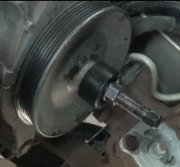You are absolutely right, and this is a real common problem that only affects GM front-wheel-drive cars because there is some adjustment in that cross member. To compound the problem, shifting the cross member moves the lower control arms to one side which tips both front wheels to one side. That is one of the three main alignment angles, called "camber", and is the first thing we look at on the alignment computer. On most older Chrysler products one of the two lower strut mounting bolt holes is slotted to allow adjusting of camber. On GMs with original struts, one of the holes has to be ground out to an oval to make camber adjustable the first time the car is aligned. Typically that's all the mechanic looks at, and it's often possible to get camber back to specs, but that doesn't address the underlying problem.
You need to tell the mechanic to check and adjust "steering axis inclination", (SAI). All alignment computers do that automatically, but we don't bother to look at it unless we know to look for this problem. There actually is never a spec given for SAI. A typical value is from 28 to 32 degrees, but all that is critical is both sides are the same. We accomplish that by sliding the cross member with a pry bar during the alignment.
"SAI" is a fancy word for the angles of the struts as viewed from in front of the car. It refers to the two steering pivots. On older cars and trucks that would be the upper and lower ball joints. Drawing an imaginary line through those two joints and comparing that to true vertical is the SAI angle. On your car the steering pivots are the lower ball joint and the upper strut mount. The upper mounts can't move because they're a welded part of the body sheet metal. You can move the lower ball joints by moving the cross member and lower control arms, and that changes SAI, but then readjusting camber might get the wheels back to vertical, but it didn't correct SAI. That's where the miserable handling comes in that you described perfectly.
Inexperienced alignment mechanics will just try to correct camber without asking themselves why both front wheels are tipped a lot to the right or the left. The cause will dawn on some of them when they adjust camber as far as possible and at least one wheel can't quite go far enough to hit specs, or it has to be adjusted as far as it can go. A typical camber spec for a lot of GM front-wheel-drive cars is 0.00 degrees, which means that wheel is perfectly straight up and down. That's not common on most other cars. For best tire wear camber is typically around 0.25 to 0.50 degrees meaning they're tipped out on top a very small amount. If you can imagine a wheel and tire laying flat on its side, that would be 90.00 degrees. The maximum range of adjustment on GM cars is around plus or minus 3.00 degrees. Under normal conditions, like sagged springs, slightly bent parts, and normal wear, it is rare to have to adjust camber more than half a degree to bring it back into specs, even when parts are replaced, so when a mechanic finds camber is off by more than 3.00 degrees, and especially when BOTH wheels are off that much, it has to occur to him that something is wrong, and that he should be checking SAI.
Sunday, February 8th, 2015 AT 5:23 PM


